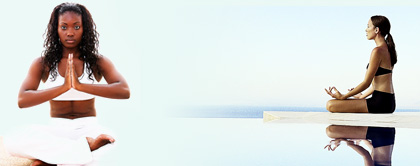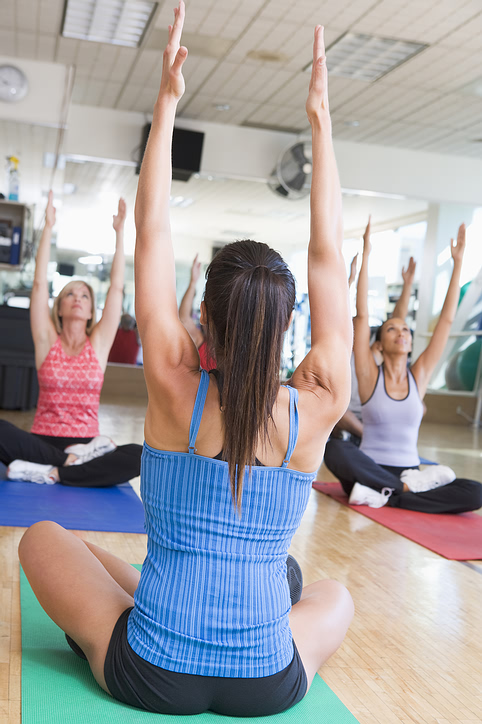 |
 Greetings! Greetings!
Did you know yoga can be a competitive sport and that there is an effort underway to make it an Olympic event? You can read about it here. We'd love to know what you think about that - please visit our Facebook page to take our one-question poll and leave a comment.
What's "hot" in yoga? Hot Yoga! Find out more about this new class led by Erin Harris. Erin was introduced in last month's newsletter. Her Hot Yoga class is on Tuesday, Thursday and Friday evenings, 5:30-6:30 p.m. and Wednesday mornings, 7:30-8:30 a.m.
Warrior 3 is a powerful pose that improves your balance. Learn how to do it here.
Don't forget Naturopath doctor Jaime Sanchez is conducting workshops on various Saturdays targeting specific problem areas. The first was on March 10 and dealt with back pain. Next workshop will be on March 17 and continue the same topic.
We have a wide variety of classes (and times) to offer! We're sure we have something that will fit into your schedule. Check out our list of classes.
Namasté,
Theresa Franklin, NCTMB, LMT, RYT, CMT
Olivia Kelly, NCTMB, LMT
|
 |
 Can Yoga be Competitive? Can Yoga be Competitive? 
Debate whether yoga should be a competitive sport has been renewed recently and some are even suggesting yoga belongs in the Olympics. Olympic sport? Competitive? That does seem counter intuitive to the non-judgmental perception of yoga. Yoga competitions are not new. They've been around since at least 1975 when the Pondicherry Yoga Association (PYA) in India held its first state yoga championships (and some argue as long ago as 1,200 years). Rajashree and Bikram Choudhury participated in them and according to Bikram Choudhury's bio on bikramyoga.com, he won the National India Yoga Championship in 1959 when he was 13. In 1989, the International Federation of Yoga Sports held the first World Yoga Championships. Europe has its annual European Yoga Championships, organized by the European Yoga Alliance, while the US and Canada has regional competitions. More recently, Bikram Choudury began organizing his International Yoga Asana Championship in 2003. How does a yoga competition work? Participants must do a series of seven yoga poses in three minutes. Five of those poses are required - standing head-to-knee pose; standing bow pulling pose; bow pose; rabbit pose; and stretching pose - but participants can choose their last two poses. You can see the poses and read what judges look for here. Rajashree Choudhury, founder of USA Yoga, held the National Yoga Asana Championship March 2-4 in New York. Winners of state meets competed March 3 in national semi-finals and the finals on March 4. Winners will take part in an international competition in June in Los Angeles. But does yoga belong in the Olympics? Yogasiromani Gopalji, executive director of The World Yoga Council, is at the forefront of the push to get yoga in the Olympics, which would be in 2020 at the earliest. The argument against the idea of yogis "going for the gold" is that yoga is not about competing with others or about achieving perfection. The roots of yoga are based in acceptance and non-violence and compassion toward self and others," says Roseanne Harvey, who's been practicing yoga for 15 years and blogs about it at itsallyogababy.com Others, such as Rajashree Choudhury, founder of USA Yoga, argue that competition can be a way to interest people in yoga who might otherwise be turned off by its spiritual aspects. She says the poses show how "someone can have perfect strength, balance, flexibility in the body." The International Yoga Federation has proposed outlining a system that judges competitors on physical and mental performance, as well as given spiritual, social, ecological, cultural and philosophical evaluations - all very subjective. Maybe the point is moot. With Olympic sports typically very action-oriented and focused on who crosses the finish line first, will spectators be willing to watch a yogi maneuver his or her way into a pose?
Tell us what you think! Go to our Facebook page and take our one-question poll about yoga as a competitive sport.
|
 |
  Warrior 3 Warrior 3
Virabhadrasana III
(veer-ah-bah-DRAHS-anna)
Virabhadra = the name of a fierce warrior, an incarnation of Shiva
As its name implies, this variation of Warrior makes you feel powerful and centered. You can move into this standing and balancing pose from either Warrior 1 or Mountain. This sequence starts you in Warrior 1. The blueprint The yogi stands on one leg with raised leg, arms and torso parallel to the floor, gaze steady. How to do it - Start in Warrior I with your arms extended overhead and your palms touching, left foot forward.
- Inhale as you bring your weight forward into your left foot. As you exhale, lift the back leg up and out, hinging at the hips to lower the arms and torso down until they are parallel to the floor while straightening the left leg.
- Keeping your neck relaxed and in line with your spine, look down at the floor. Find a point to focus on for balance. Reach out through the right toes and the crown and fingers, making one straight line.
- Flex your right foot as though you were pushing the bottom of that foot into a wall behind you. At the same time imagine you're pressing your fingertips into the wall in front of you.
- Hold for 3-10 breaths.
- Gently lower your right leg to the floor, coming back into Warrior 1.
- Repeat on the other side.
Do: - keep your abdomen tight for stability
- keep both hips facing the floor
- engage your entire body but keep the glutes relaxed and the shoulders drawn away from your ears
- elongate your body as much as possible; this makes the pose easier to hold
- think about "lines of energy" throughout your body
Don't: - lock or hyper-extend the knee of the standing leg
- bend either knee, but do keep them "soft"
Benefits - Strengthens the ankles and legs
- Improves balance and concentration
- Tones the abdomen
- Strengthens the shoulders and muscles of the back
Contraindications - Recent or chronic injury to the legs, hips, back or shoulders.
- High blood pressure
Beginners tips and modifications Try this pose at a wall for support. You can either face the wall so your hands lightly touch it or turn away from it so your raised foot touches it. Advanced practitioner variations You can bring your arms back along your sides, palms up; stretch them out to the sides; put them on your hips; or bring them into reverse namaste position behind your back. |
 |
 Hot Yoga with Erin Harris: a Non-traditional Style Hot Yoga with Erin Harris: a Non-traditional Style
The hot yoga class Erin Harris teaches is a very non-traditional hatha yoga form, different from the Bikram yoga style.
The most notable difference is that the studio typically is set between 85-90 degrees, unlike the 105 degrees used in Bikram yoga. The temperature of the yoga room is similar to our body's own temperature. This accelerates improvement in many of the benefits of your yoga practice.
Another difference is that Erin doesn't use the standard 26-asana sequence Bikram yoga uses. Instead, she prepares a sequence for each class to work different parts of the body that changes over the course of several classes.
Interest in the class is growing, so much so that the Tuesday evening traditional yoga class is now a fourth hot yoga session. Class size averages about 10-15 students -- large enough to allow good interaction among the group but small enough still to keep it personal with a private studio atmosphere.
Erin says she takes time at the beginning of each class to bring to the students' focus a daily intention that will be the center of the class. For example, the intention for a recent class was "welcoming change in our lives." While everyone is seated in easy sit with their eyes closed, concentrating on their breath work, Erin gives a brief lesson on the intention.
To warm up the breath, Erin says she has the class practice deep Ujjayi breathing, alternate nostril breath work or the three-part yoga breathing technique.
To warm up the body, the class does neck, hip and arm rotations, toe touches, easy forward and back bends and last, but certainly not least, Sun Salutation.
After warming up the body and breath, the class performs the asanas, followed by a relaxing svasana and reconnecting with the group.
Some benefits of hot yoga include:
- Your body burns fat more effectively
- The heat produces a fluid-like stretch allowing for greater range of movement in joints, muscles, ligaments and other supporting structures of the body
- Capillaries dilate in the heat, more effectively oxygenating the tissues, muscles, glands and organs and helping in the removal of waste products
- You benefit from a strengthening of willpower, self-control, concentration and determination in this challenging environment
- Your cardiovascular system gets a thorough workout
- Your muscles and connective tissue become more elastic and allow for greater flexibility with less chance of injury and improved resolution of injury
- Sweating promotes detoxification and elimination through the skin, which is the body's largest eliminating organ
- Just as when your body raises its temperature to fight infection, the raised temperature in the room will assist in improving T-cell function and the proper functioning of your immune system
- Your nervous system function is greatly improved and messages are carried more efficiently to and from your brain
- Metabolism improves in your digestive system and in the body's cells
Erin teaches hot yoga Tuesday, Thursday, and Friday at 5:30-6:30 p.m. and Wednesday morning 7:30-8:30 a.m.
back to top
|
 |
|
Be Well Now
is a healthy lifestyle center that offers a range of holistic experiences to unite your mind, body and spirit. Bring harmony to your life through the practice of heart-centered yoga and meditation. Explore our Namasté gift shop with books, CDs, candles, teas, skin care and gifts.
Stop by and check us out!
Be Well Now
(618) 462-3900
|
The Be Well Now newsletter is edited by Danette Watt. For suggestions, comments or concerns about the newsletter content, contact her at dmwatt33@gmail.com.
|
|
Teacher Training
Jaime Sanchez of East-West Natural Healing School of Yoga will be offering Yoga Alliance approved teacher training in February 2013 at Be Well Now. Details to follow.
|
 Good to know.... Good to know....
Pick up a handy bookmark listing all of our classes in one convenient, easy-to-read format. |
 Our classes Our classes YOGA Sunday 9:00-10:00 a.m. Monday 9:00-10:00 a.m. 4:00-5:00 p.m. Tuesday 9:00-10:00 a.m. 5:30-6:30 p.m. Wednesday 7:30-8:30 a.m. Wake-up Yoga 4:00-5:00 p.m. 6:00-7:00 p.m. Thursday 7:30-8:30 a.m. Wake-up Yoga 11:00-11:45 a.m. & 12:00-12:45 p.m. Lunch Hour Yoga 5:30-6:30 pm Hot Yoga Friday 9:00-10:00 a.m. 5:30-6:30 p.m. Hot Yoga Saturday 11 a.m. - 12 p.m. TAI CHI Monday 6:30-7:30 p.m. Wednesday 11 a.m. - 12 p.m. TANG SO DO Tuesday/Thursday 7:00-8:30 p.m. |
|